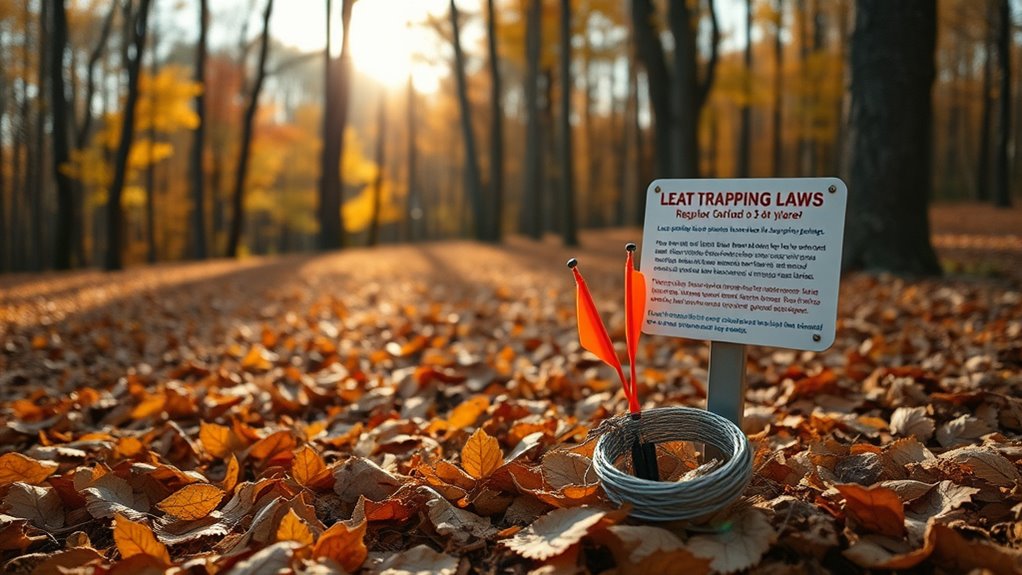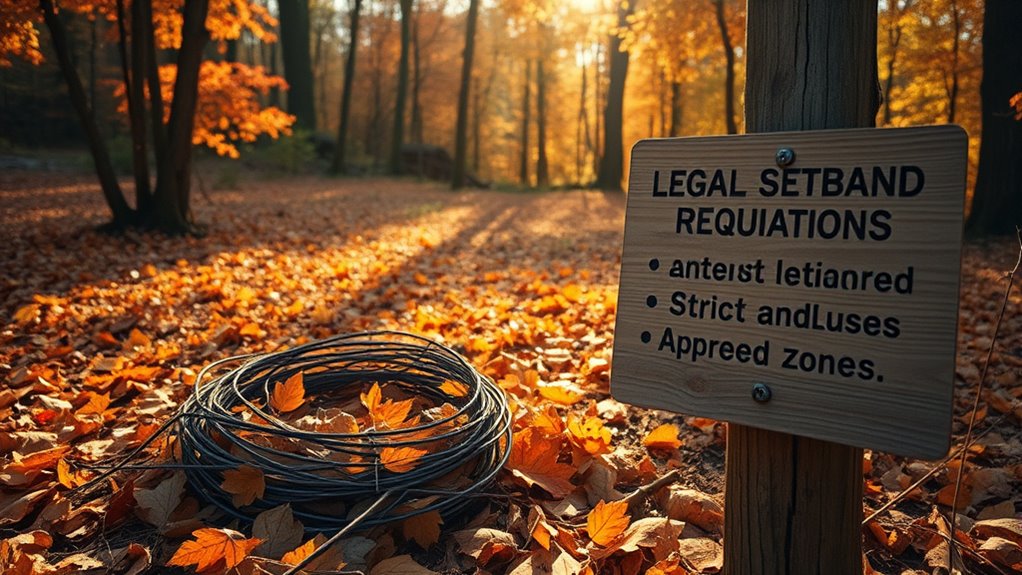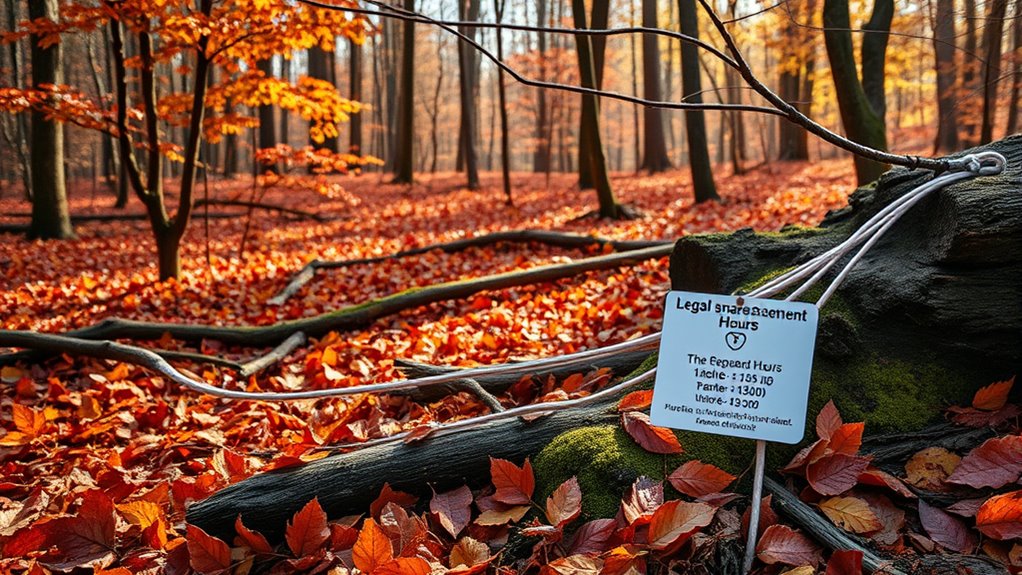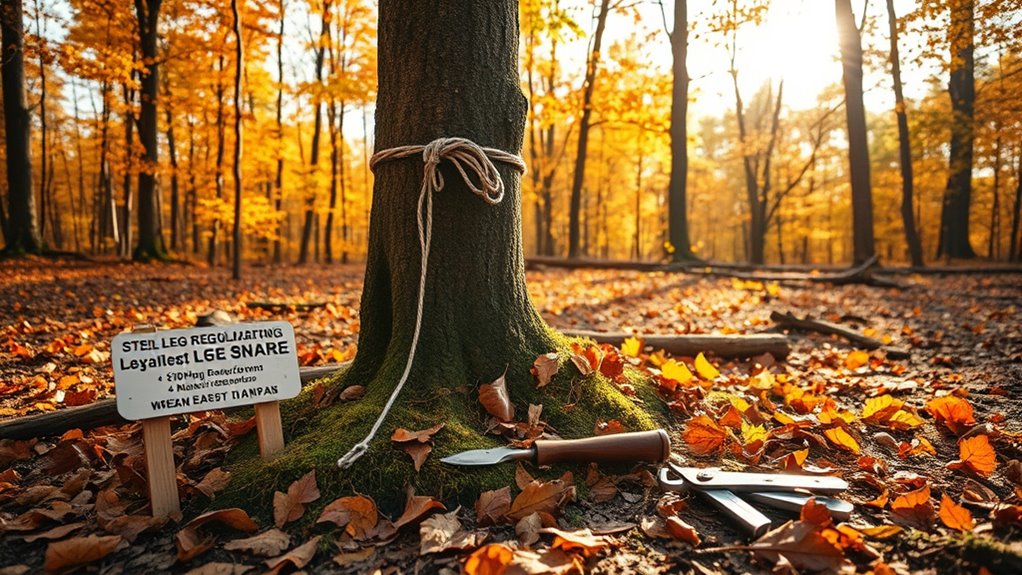To set snares legally during autumn, you must follow local wildlife laws, obtain the necessary permits, and choose approved locations within designated trap zones. Stay mindful of seasonal time restrictions and maintain proper setbacks from property lines and water sources. Use well-constructed, discreet traps that meet legal standards and avoid protected species. Keep detailed records of your setups and ensure compliance to prevent penalties. Continue to explore these regulations to stay fully lawful and ethical in your trapping efforts.
Key Takeaways
- Obtain all necessary permits and licenses before setting snares in autumn.
- Follow seasonal trapping regulations, including specific open and closed dates for snares.
- Set snares only within approved zones and maintain minimum setback distances from property and water sources.
- Ensure trap placement adheres to time restrictions, typically dawn to dusk, during autumn.
- Use compliant, approved trapping equipment and inspect regularly to prevent unlawful captures.
Understanding Local Wildlife and Trapping Laws

Before setting snares, understanding the wildlife in your area and the laws that govern trapping is essential. Knowing which species inhabit your region helps you target only appropriate animals, supporting habitat preservation and avoiding unnecessary harm to non-target species. Public education about local wildlife promotes responsible trapping practices, ensuring you respect the ecosystem’s balance. Familiarize yourself with regional regulations, as laws vary widely and often specify which species can be trapped and when. This knowledge not only keeps you compliant but also encourages ethical trapping, emphasizing conservation efforts. Recognizing trap-specific regulations can help you select suitable equipment and methods aligned with legal standards. Additionally, understanding local species behavior can improve trap effectiveness and reduce unintended captures. Being aware of vehicle and trapping laws ensures your activities remain within legal boundaries while protecting wildlife populations. Staying informed about seasonal trapping restrictions can prevent legal issues during specific times of the year. Incorporating haute couture principles into your trapping approach—such as precision and craftsmanship—can enhance the effectiveness and sustainability of your efforts. By understanding local wildlife and legal requirements, you contribute to habitat preservation and demonstrate respect for the environment, making your trapping efforts both effective and responsible.
Permits and Licensing Requirements for Snares

Do you know what permits or licenses you need before setting snares? Many regions require you to obtain specific trapping permits or licenses to guarantee legal compliance. These permits often specify the types of traps you can use, including snares, and may limit trapping to certain seasons or areas. Proper snare maintenance is vital to prevent unnecessary suffering and ensure the trap functions correctly. Additionally, you must know how to dismantle traps safely once your activity is complete or if they become damaged. Failing to acquire the necessary permits or neglecting proper trap dismantling can lead to fines or legal trouble. Always check local regulations to confirm your licensing requirements, and keep your permits up to date to trap legally and responsibly. Understanding trapping regulations is essential to ensure your activities remain within legal boundaries. Moreover, staying informed about regulatory updates can help you adapt your practices to any changes in the law.
Approved Locations and Setback Regulations

You need to know where you can legally set your snares, which includes designated trap zones and specific setback distances from property lines or dwellings. Make sure you’re aware of restricted areas where trapping is prohibited or restricted, and check if any exemptions apply to certain locations. Additionally, understanding regulatory compliance ensures your practices align with current laws governing trapping. Being familiar with local regulations can help prevent inadvertent violations and potential penalties. Following these rules helps guarantee your trapping activities stay within legal boundaries and avoid penalties, especially when considering trap placement laws that specify where traps can be set. Awareness of animal behavior patterns can also improve your trapping strategy while remaining compliant with regulations. Regularly consulting official trapping guidelines can further ensure your activities are lawful and effective.
Designated Trap Zones
Designated trap zones are specific areas where trapping is legally permitted, and understanding their boundaries is essential for compliance. You need to familiarize yourself with these zones to avoid legal issues and ensure ethical trapping. Using your bushcraft skills, you can identify suitable locations within authorized zones, such as along game trails or near water sources. Make sure your trapping gear is set up only in these approved areas, respecting the boundaries established by local regulations. Staying within designated trap zones helps protect wildlife populations and maintains your legal right to trap. Properly understanding these zones helps ensure humane trapping practices and keeps your trapping efforts safe, legal, and effective. Always verify zone boundaries before setting your snares, and carry maps or GPS devices to avoid accidental trespassing. Properly understanding these zones keeps your trapping efforts safe, legal, and effective. Legal trap zone boundaries are defined to regulate humane and sustainable trapping practices. Additionally, understanding family dynamics can influence how regulations are communicated and enforced within communities. Incorporating advanced materials used in energy technology into your knowledge can help you better understand how equipment and enforcement tools are developed for durability and effectiveness.
Minimum Setback Distances
Minimum setback distances are key to ensuring your trapping activities remain legal and safe. These distances dictate how far your traps must be from property lines, roads, or water sources. To stay compliant, consider these points:
- Maintain a specified distance from bait placement sites to prevent accidental captures or damage. Proper placement of traps is essential for humane and legal trapping.
- Keep traps a safe distance from trails and dwellings to avoid safety hazards and legal violations.
- Regular trap maintenance is essential; ensure traps are checked frequently and kept within setback zones.
- Proper placement of traps also involves understanding the local regulations, which may specify additional restrictions or guidelines. Incorporating familiarity with local laws can help prevent inadvertent violations.
- Using appropriate trap types that comply with regional standards can further ensure your trapping remains lawful. Additionally, understanding how arcade machines work can help operators maintain equipment effectively and avoid legal issues related to malfunction or unauthorized modifications.
Adhering to setback regulations helps you avoid penalties and ensures humane trapping. It also minimizes interference with wildlife and property owners. Always verify local rules, as distances may vary by region. Proper placement and maintenance, respecting setback distances, keep your trapping efforts effective and legal.
Restricted Area Exemptions
While setback regulations generally apply to most trapping sites, certain approved locations are exempt from some restrictions, allowing for more flexibility in trap placement. These exemptions often include designated wildlife corridors and specific areas where trapping gear can be set closer to sensitive habitats. If you’re working within these exemptions, you may set snares and other trapping gear closer to certain structures or natural features, provided you follow guidelines that protect wildlife movement and prevent accidental captures. Always verify if your trapping site qualifies for these exemptions, and ensure your gear placement doesn’t disrupt wildlife corridors or violate other regulations. These allowances aim to balance effective trapping with wildlife conservation, giving you more options while maintaining legal compliance.
Time Restrictions for Snare Activation

To guarantee ethical trapping practices, you must adhere to specific time restrictions for activating your snares. These regulations help minimize unnecessary animal suffering and ensure legal compliance. First, you should only set snares during designated hours, typically dawn to dusk, to prevent trapping at night. Second, avoid using bait restrictions that could attract animals outside permitted times, like certain food attractants during closed seasons. Third, ensure your trap placement respects seasonal limitations, avoiding active periods when animals are most vulnerable. Fourth, being aware of animal behavior patterns can help you determine the most appropriate times for trap activation. Additionally, understanding local regulations and guidelines can further ensure your activities remain within legal boundaries. Following these rules ensures your snares are only active when legally allowed, reducing risks of accidental captures and illegal trapping. Staying informed about time restrictions safeguards your trapping activities while promoting ethical practices.
Proper Snare Construction and Placement Standards

Proper snare construction and placement are essential to guarantee ethical trapping and legal compliance. You must build snares sturdy enough to hold animals without causing unnecessary suffering. When placing your trap, focus on bait placement to attract your target species effectively. Trap concealment is equally important; hide your snare well to avoid detection and ensure safety. Use natural cover and strategic positioning on animal trails or game paths. Improper construction or placement can lead to illegal trapping charges or animal cruelty accusations. Remember, a well-built and discreet snare respects wildlife laws and promotes responsible trapping.
| Bait Placement | Trap Concealment |
|---|---|
| Attracts game | Hides trap from sight |
| Guides animal toward snare | Prevents animals from avoiding trap |
| Increases catch rate | Ensures ethical trapping |
| Must be natural | Should blend seamlessly |
| Critical for success | Essential for compliance |
Species-Specific Regulations and Protected Animals

You need to know which species are protected and the restrictions that apply to them. Certain animals are off-limits year-round, while others have specific seasons when trapping is allowed. Failing to follow these regulations can lead to legal trouble and harm to vulnerable populations.
Protected Species Restrictions
Are you aware of how specific regulations protect certain species from being snared? These protections aim to prevent harm to non target species and reduce accidental catches. To comply, you need to understand:
- Certain animals are fully protected and cannot be taken at any time, regardless of snaring methods.
- Restrictions are in place to minimize accidental catches of endangered or non target species, requiring careful placement and monitoring.
- Some species may be protected during specific periods or in particular areas, making snaring illegal even if the species isn’t explicitly listed.
Species-Specific Seasons
Certain species are only available for snaring during specific seasons, which are set to protect populations during vulnerable times. During autumn foliage, many animals prepare for seasonal migration, making this a critical period. By restricting snaring to designated seasons, authorities aim to prevent overharvesting when animals are most vulnerable. For example, some species are only open for snaring before or after their seasonal migration, ensuring their populations remain stable. These species-specific seasons help maintain ecological balance and support species survival. You must stay informed of these timeframes to comply with regulations. Ignoring seasonal restrictions can lead to legal penalties and harm local ecosystems. Always check your area’s specific seasons, especially during autumn, when wildlife activity increases and animals are most susceptible to disturbance.
Reporting and Record-Keeping Obligations

Proper reporting and record-keeping are essential components of legally setting snares, as they guarantee compliance with applicable regulations and facilitate accountability. You must document details such as trap gear used, locations, and dates to demonstrate lawful practices. To ensure thorough records, consider these steps:
Proper record-keeping ensures legal trapping and promotes ethical, responsible practices during autumn.
- Keep a detailed log of each snare set, including GPS coordinates and trap gear specifics.
- Report all captures to the relevant authorities within the designated timeframe.
- Regularly review and update safety protocols to prevent accidents and ensure humane trapping.
Maintaining accurate records helps verify adherence to regulations and supports responsible trapping during autumn. Following these obligations not only keeps you compliant but also promotes ethical and safe trapping practices.
Ethical Trapping Practices During Autumn

Autumn presents a critical time to prioritize ethical trapping practices that minimize harm and respect wildlife. During this season, it’s essential to contemplate ethical considerations when setting snares, ensuring you use humane trapping methods. Always select traps designed for quick, clean captures to reduce suffering. Check snares frequently, especially during autumn when animals are actively foraging and preparing for winter. Avoid setting traps in areas where non-target animals or protected species are likely to be caught. Respect breeding seasons and avoid trapping during vulnerable periods for wildlife. By practicing humane trapping, you not only comply with legal standards but also uphold ethical responsibility, ensuring that your actions cause the least possible distress and harm to animals during this crucial season.
Penalties and Enforcement Measures

When trapping practices don’t align with legal and ethical standards, enforcement agencies step in to uphold wildlife protection laws. If you use illegal trapping equipment or set snares outside permitted seasons, you face serious legal consequences. Authorities may take action such as:
- Seizing your trapping equipment and confiscating illegal snares
- Issuing fines or citations for violations
- Pursuing criminal charges that could lead to prosecution and potential jail time
These enforcement measures are designed to deter illegal trapping and promote responsible wildlife management. Understanding the penalties helps you stay compliant and avoid costly mistakes. Always verify your trapping equipment meets legal standards and follow established regulations to prevent enforcement actions and protect wildlife populations effectively.
Frequently Asked Questions
Can I Set Snares on Private Property Without Permission?
You can’t set snares on private property without permission. Legal considerations and property rights protect landowners’ interests, so doing so without consent can lead to legal trouble. Always seek the landowner’s permission before setting any traps. Respecting property rights ensures you’re acting within the law and helps avoid disputes. Remember, unauthorized trapping can be considered trespassing or poaching, which are serious offenses.
Are There Specific Bait Restrictions for Autumn Trapping?
You ask if there are bait restrictions for autumn trapping. Yes, you should check local regulations because bait restrictions can vary; some areas limit certain bait types to prevent non-target species from being caught. When setting traps, also pay attention to trap placement rules to guarantee safety and compliance. Always stay informed about specific seasonal rules to avoid legal issues and protect wildlife during autumn trapping.
How Do Weather Conditions Affect Snare Effectiveness?
Did you know that cold, rainy weather can diminish snare effectiveness by up to 30%? Weather impact is significant; rain can cause snares to slip or rust, while wind can displace them. You should make trap adjustments, like tightening or repositioning snares after storms or during temperature fluctuations. Being mindful of weather conditions helps guarantee your traps work effectively and ethically, especially during unpredictable autumn weather.
What Safety Measures Should I Take When Setting Snares?
When setting snares, prioritize safety by wearing proper safety equipment like gloves and eye protection. Always check trap placement to avoid hazards to yourself and others, guaranteeing snares are secure and stable. Use clear markings or flags to alert others of your traps, and handle all equipment carefully. These safety measures help prevent accidents and ensure responsible trapping practices during autumn.
Are There Seasonal Changes in Trapping Regulations During Autumn?
Did you know that seasonal trapping regulations often change by up to 25% during autumn? During this season, you’ll find specific rules for setting snares, as authorities aim to protect wildlife during vulnerable periods. It’s vital to follow autumn regulations closely, as they may restrict trap locations, types, or times. Staying informed ensures you trap legally and ethically while respecting the seasonal needs of local wildlife.
Conclusion
By following these autumn regulations, you’ll navigate the trap of legal pitfalls as skillfully as a seasoned hunter in the woods. Remember, just like the wise fox respects the boundaries of the forest, respecting trapping laws guarantees you stay within the shadows of legality. Stay informed, act ethically, and keep records clear—so you can confidently move forward, knowing you’re part of a responsible tradition that preserves nature’s balance.










